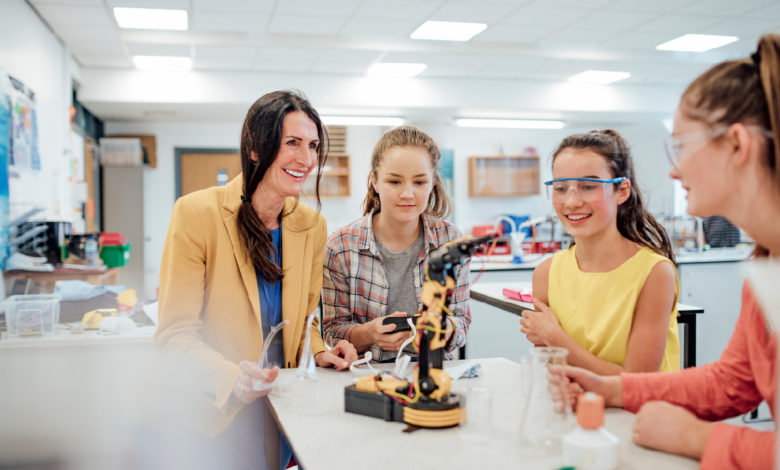
Here is what Karen Panetta wants you to know about getting more girls interested in studying for STEM careers: It is a matter of meeting girls where their interests are.
“Unfortunately, we still use the filter that to be good at STEM you have to be good at math and science,” says this IEEE Senior Member. Panetta is Dean of Graduate Education and a professor of electrical and computer engineering at Tufts University, as well as the founder of Nerd Girls, which encourages college women in STEM.
“But sitting a girl at a table and loading her up with math worksheets, or insisting on competition-style robotics programs, when they are not her thing, isn’t the answer,” Panetta continues. “Girls need to develop the skills, confidence and passions that will make them unique, authentic individuals – and and that may lead them to a STEM career.”
Along with co-author Katianne Williams, Panetta has now written an authoritative and information-packed volume to help parents, teachers and counselors guide girls into accomplishing their dream careers though STEM.
In Count Girls In, published by Chicago Review Press, the authors have two goals: to dispel stereotypes about girls’ capabilities, and to encourage them to combine their natural talents with a STEM field – so they have a better chance of working in a profession they love. A girl who has a passion for art, for example, can be encouraged to supplement this with classes in graphic design, or 3D printing.
“The key is not to change girls’ natural interests, but to meet them where they are, and incorporate STEM lessons from there,” says Panetta.
She notes that Count Girls In, published on 1 August, was the #1 STEM book on Amazon’s pre-release list. By mid-August, it was the #1 new release on STEM education. Panetta and Williams are looking forward to a book tour this fall that will include Boston, Washington, D.C., Los Angeles and San Diego. In October, Panetta will promote the book in Japan.
One vital message she and Williams stress is that parents need to put less emphasis on perfection. “Today’s children are often taught that they have to win all the time, and be perfect,” she observes. “But failure is good, because it teaches valuable lessons. It’s also part of the process of being innovative.”
The authors interviewed top female STEM professionals to learn what influenced them in their career choices, and to obtain their tactical advice for today’s girls’ interests in STEM at every stage of schooling – from elementary school to their college years. Mentors and career counselors will also find additional help through the many resources listed throughout the book.
In one especially valuable chapter about the variety of STEM jobs currently available, Panetta and Williams list about 40. In addition, for each, they offer detailed descriptions of the work; and give appealing, factual examples that illustrate how STEM professionals in that field contribute to society. For example, they explain the important role of aerospace engineers in NASA’s Cassini spacecraft and the Mars Curiosity Rover; as well as in fighting fires, search and rescue, and studying wild animal habitats. Other STEM occupations that they discuss include bioinformaticists, cybersecurity analysts, human factors engineers and humanitarian engineers – along with electrical engineers, computer engineers, and other traditional engineering professions.
The profiles of a variety of successful women in STEM careers add important perspective to the authors’ messages. In a discussion about the value of math, they provide the story of Nicole Sallak Anderson. Currently Chief Technical Officer of SapientX, which develops conversational AI interfaces, so humans can converse with robots, Anderson recalls being interested in computer science in high school. But what she describes as “a bad case of senioritis” made her drop pre-calculus and math her senior year. As a freshman at Purdue University, she had to take several remedial classes – that didn’t count toward her computer science degree – just to catch up.
“The remediation set me up for success” says Sallak Anderson. “Why in the world would I give up a career in software just because I wasn’t a genius at calculus? The thought never occurred to me.”
Both Panetta and Williams stress that despite the title of their book, the information it contains is gender neutral. “The advice and takeaways in Count Girls In is just as important for boys as it is for girls,” says Panetta. “It’s important that we foster the STEM talents of all youth.”
Co-author Katianne Williams was one of Panetta’s original Nerd Girls, when the program debuted in 2000 at Tufts. After earning her undergraduate degree in Computer Engineering at Tufts, she obtained an MFA in Creative Writing from George Mason University. Now a journalist, she is an award-winning contributor to IEEE Women in Engineering Magazine.
Count Girls In: Empowering Girls to Combine Any Interests with STEM to Open Up a World of Opportunity by Karen Panetta, Ph.D., and Katianne Williams, is available from Barnes & Noble, Amazon and other booksellers. The trade paperback is $16.99.
Helen Horwitz is an award-winning freelance writer who lives in Albuquerque, N.M. She was with IEEE from 1991 through 2011, the first nine as Staff Director, IEEE Corporate Communications.






